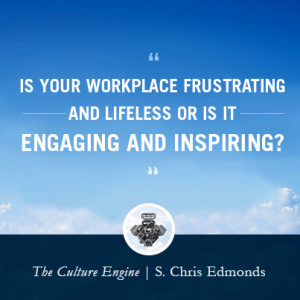 Helping leaders drive positive culture change is a life-long passion for workplace consultant S. Chris Edmonds. Chris’ latest book, The Culture Engine, lays out a road map that will help any leader–from top executive to frontline supervisor–completely overhaul or simply refine their existing workplace culture. Recently, Chris and I chatted about his new book. Here is what he had to say about why this topic merits yet another leadership book, and how leaders can use the book’s content to create engaging, fun (he calls it the “other ‘F’ word’) places to work.
Helping leaders drive positive culture change is a life-long passion for workplace consultant S. Chris Edmonds. Chris’ latest book, The Culture Engine, lays out a road map that will help any leader–from top executive to frontline supervisor–completely overhaul or simply refine their existing workplace culture. Recently, Chris and I chatted about his new book. Here is what he had to say about why this topic merits yet another leadership book, and how leaders can use the book’s content to create engaging, fun (he calls it the “other ‘F’ word’) places to work.
JVM: There are thousands of books on this topic. Why write another one?
SCE: Well, organizations still suck. We spend so much time in our workplaces and many of those workplaces are not nice. They are not happy, they are not trustful, they aren’t dignified, and they don’t honor people’s efforts. And, people get sicker in those environments. So, even with all of these books about great leadership, apparently leaders don’t “get it” yet. [Research tell us] that low employee engagement costs organizations money, it costs them customer relationships, and it creates a dynamic in workplaces that is much more competitive than it is cooperative.
JVM: Your book encourages leaders to focus not only on results (performance metrics) but also on the way people treat one another. Why is this important?
SCE: Western societies, and I think we Americans in particular, are still hanging onto industrial age ideas, in which the key theme is, “let’s get processes figured out and then no one will make mistakes.” For years, the thinking has been to focus on the most efficient actions and then we should see higher quality products and services. The prevailing thinking is, “If we do this, then we should see more efficient use of time and energy and therefore, greater profits, bottom-line.”
You know, profits are a very good thing. But there’s so much more to the equation. [If a leader] holds human interactions and human relationships out of the conversation you are not going to inspire anybody to do anything. You are really not. All you can do as an influencer, as a leader, is to craft an environment where people bring their natural motivations into play. And that requires looking at things beyond just “did we get the results we expected?”
JVM: More than a third of your book is devoted to defining and creating an “Organizational Constitution.” Give us the highlights.
SCE: Just as many societies have formalized platforms of liberating rules, so too can a company. An organizational constitution is a formalized document that guides our plans, decisions, actions, and treatment of each other and our customers. A constitution may be for the entire organization, or for just the department (or division) that a leader helms. At first these guidelines may be aspirational and that’s ok. But as it takes shape, the constitution gets crafted into a set of specific agreements that spells out how we will operate. There are four parts to an organizational constitution: the organization’s (or department’s) purpose, values, strategies and goals.
JVM: Can an individual leader really make a difference by implementing an organizational constitution in his or her department—especially if the rest of the organization has a toxic culture?
SCE: Absolutely. I have had terrific experience in influencing leaders of smaller intact functions. It might be a sales team, or a business unit, or one retail store that’s part of a larger global organization. In all cases, [the leaders of that smaller intact function] decided that the way the “system” [the overall company culture] was operating wasn’t working. And they wanted to make a change, but they didn’t know what to do, so they brought me in. The results are typically increases in productivity, in customer service satisfaction, and increase in profits as compared to departments who aren’t actively implementing these culture change ideas.
I want to thank Chris for his time and for sharing these wonderful insights with the readers of The People Equation.
If you want to learn more about the concepts in this book, check out my Culture Engine series , which features other posts related to his book. Are you on social media? Check out #TheCultureEngine to follow trending topics on this book.
Disclosure: I received a free copy of this book for the purposes interviewing the author. Some of the links in this post are affiliate links. Please know that I only share information that I believe will be useful to my readers. For more information, see The People Equation disclosure statement.
Leave a Reply